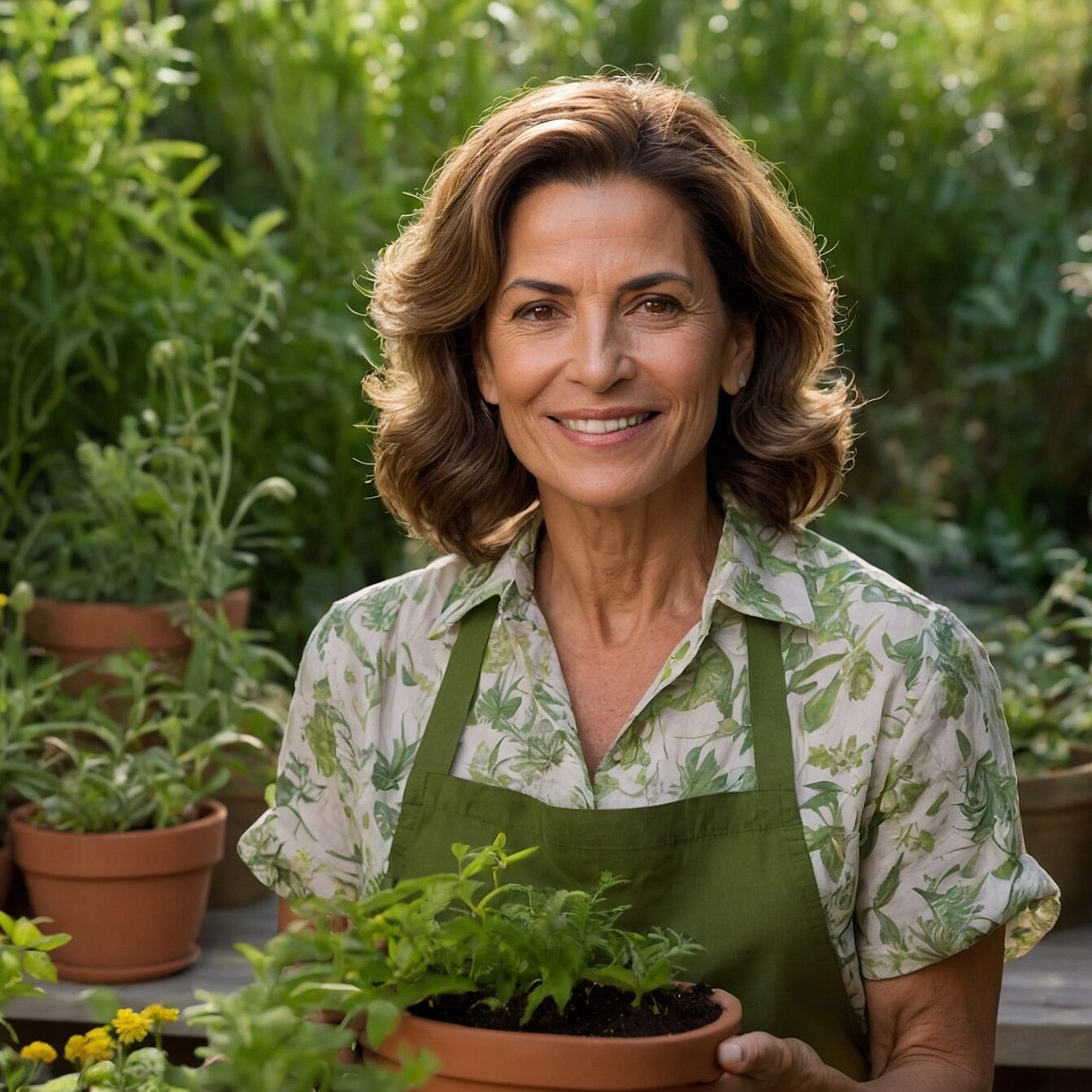Table of Contents
Introduction
Rare succulents have won the hearts of many plant enthusiasts around the world. With their varied shapes, vibrant colors and ability to thrive in adverse conditions, these plants are a true spectacle of nature. Succulents are plants that store water in their leaves, stems or roots, which allows them to survive in arid environments. This characteristic makes them not only interesting, but also incredibly practical for those who want a touch of green in their home without the need for constant care.
In recent years, the popularity of succulents has skyrocketed. From small urban apartments to large gardens, these plants have become a favorite choice for decoration and landscaping. Succulents are appreciated for their low maintenance and their ability to adapt to different environments. In addition, their aesthetic diversity allows each collection to be unique, reflecting the style and personality of those who grow them. Social media has also played a crucial role in spreading the love of succulents, with thousands of photos and care tips shared on a daily basis.
Although there are many popular and widely available succulents, there is a special fascination with rare succulents. These unique plants are often sought after by collectors and enthusiasts who want something truly special in their collections. In this article, we’ll explore five rare succulents that stand out for their unusual characteristics and exotic beauty. Let’s find out what makes each of these plants so special and how you can grow them successfully.
- Lithops (Living Stones): With their uncanny resemblance to stones, these succulents are masters of camouflage.
- Euphorbia obesa (Baseball Plant): Known for its spherical shape, this plant is a true icon among rare succulents.
- Haworthia truncata (Window Haworthia): Its truncated, translucent leaves make it one of the most intriguing succulents.
- Ariocarpus fissuratus (Living Rock Cactus): Growing slowly and looking like a living rock, this plant is a fascinating example of adaptation.
- Avonia papyracea (Paper Avonia): With its stems covered in white bracts, this delicate succulent is a true work of natural art.
Get ready to dive into the world of rare succulents and discover how each of these wonders can bring a special and exclusive touch to your plant collection.
1. Lithops (Living Stones)
Plant description and origin
Lithops, also known as “Living Stones”, are a genus of succulents belonging to the Aizoaceae family. Originally from the arid regions of southern Africa, these plants have developed in rocky and desert areas, where they camouflage themselves between rocks to avoid predators. Their peculiar appearance and adaptability to extreme conditions make them one of the most fascinating and sought-after groups of succulents for collectors.
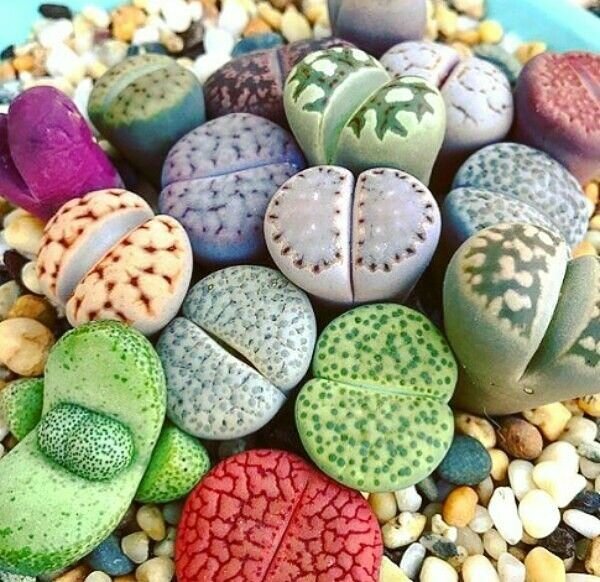
Unique characteristics
Lithops ‘ most distinctive feature is their striking resemblance to small stones or pebbles. This natural camouflage helps the plant protect itself from herbivores and survive in difficult habitats. Each plant consists of two thick, fleshy lobes, which store water to sustain the plant during periods of drought. In autumn, Lithops produce colorful, showy flowers that emerge from between the lobes, usually yellow or white, adding a vibrant touch to their usually discreet appearance.
Care Tips
Caring for Lithops can seem challenging, but with a few basic tips, you can ensure that these rare succulents thrive in your home:
- Light: Lithops need plenty of direct sunlight. Place them in a spot where they receive at least 4-5 hours of direct sunlight a day, such as a south or west-facing window.
- Watering: The main rule for watering Lithops is to avoid overwatering. During the summer, water moderately, only when the soil is completely dry. In winter, when the plant goes into dormancy, drastically reduce watering or stop watering altogether. Overwatering can lead to root rot.
- Soil: Use a well-drained substrate, such as a specific mix for cacti and succulents. Add coarse sand or perlite to improve drainage. Avoid soils that retain too much moisture.
- Pot: Choose shallow pots with drainage holes. Lithops have a shallow root system and do not require deep pots.
- Temperature: Although they tolerate high temperatures, lithops prefer moderate temperatures. Protect them from frost and extremely low temperatures.
With proper care, Lithops can become a long-lasting and fascinating addition to your plant collection. Their unique appearance and beautiful flowers are a rewarding treat for any succulent lover.
2. Euphorbia obesa (Baseball Plant)
Description and Origin
Euphorbia obesa, popularly known as “Baseball Plant”, is a succulent belonging to the Euphorbiaceae family. This plant originates from the arid regions of the Cape Province in South Africa. Due to its unique shape and robust appearance, it has become a favorite among collectors of rare succulents.
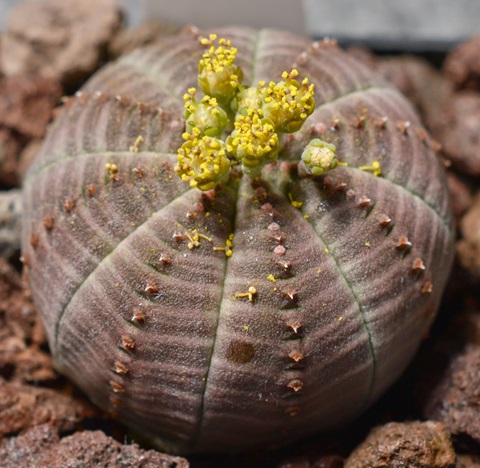
Distinctive features
Euphorbia obesa stands out for its spherical shape, reminiscent of a baseball, hence its popular name. When young, the plant is almost perfectly round, but as it gets older, it can become more cylindrical. Its surface is covered in vertical grooves that give the plant a segmented texture. In addition, Euphorbia obesa has fine marks or lines along its furrows, which can be green, grayish or reddish, depending on exposure to sunlight and the stage of growth.
Care required
Caring for Euphorbia obesa is relatively simple, as long as a few guidelines are followed:
- Watering: Like many succulents, Euphorbia ob esa requires a careful watering regime. During spring and summer, when the plant is actively growing, water moderately, allowing the soil to dry out completely between waterings. In the fall and winter, reduce the frequency of watering, as the plant enters a state of dormancy and requires less water. Over-watering can cause root and stem rot.
- Soil type: Use a well-drained substrate specifically for cacti and succulents. A mixture of sandy soil or perlite is ideal to ensure good drainage. Avoid soil that retains too much moisture, as this can harm the plant.
- Ideal temperature: Euphorbia obesa prefers warm temperatures and can tolerate high temperatures during the summer. However, it must be protected from extremely low temperatures. Ideally, keep the plant at temperatures above 10°C (50°F). If grown indoors, choose a location that receives plenty of indirect sunlight.
- Brightness: This plant thrives in bright environments, but prefers bright indirect light. Prolonged direct exposure to intense sunlight can cause the plant to burn. Place it in a spot where it receives filtered or partial light.
- Pot: Opt for pots with adequate drainage holes to avoid water accumulating in the roots. Clay or ceramic pots are recommended as they allow moisture to evaporate better.
With proper care, Euphorbia obesa can become an attractive centerpiece in any succulent collection, enchanting with its unique shape and interesting texture. Its relatively simple maintenance requirements make it an excellent choice for beginners and experienced collectors alike.
3. Haworthia truncata (Window Haworthia)
Description and Natural Habitat
Haworthia truncata, also known as “Window Haworthia”, is a succulent belonging to the Asphodelaceae family. This plant is native to the semi-arid regions of the Cape Province in South Africa. Growing in rocky and sandy areas, Haworthia truncata adapts to environments with intense indirect sunlight and well-drained soil, characteristic of its natural habitat.
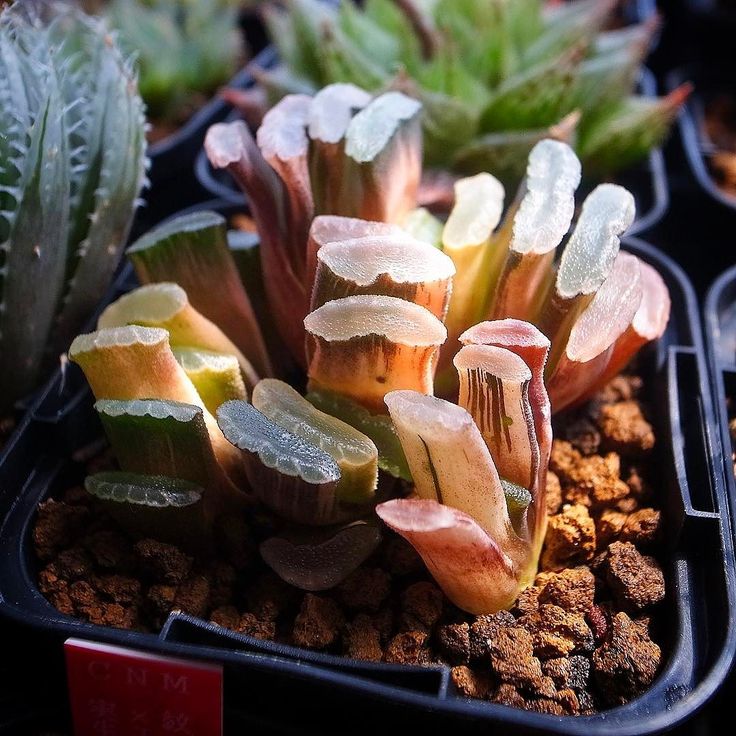
What Makes This Succulent Rare
Haworthia truncata is highly prized by collectors due to its unique and distinctive appearance. What makes it rare and special are its truncated leaves, which appear to have been cut or flattened at the top. These leaves have a translucent pattern at the ends, allowing light to penetrate the plant, a phenomenon known as “windowing”. This aspect not only contributes to the plant’s unusual aesthetics, but also aids photosynthesis in environments with limited light. The combination of these characteristics makes Haworthia truncata an intriguing and desirable piece in any succulent collection.
Growing Instructions
Growing Haworthia truncata can be a rewarding experience, especially when its specific needs are met. Here are some tips to ensure the healthy growth of this rare succulent:
- Brightness: Haworthia truncata thrives in environments with bright but indirect light. Direct exposure to intense sunlight can cause burns to the leaves. Place the plant where it receives filtered light, such as near a window with a light curtain, or in a space with partial sunlight.
- Watering: Watering Haworthia truncata properly is crucial to its well-being. During spring and summer, when the plant is actively growing, water moderately, allowing the soil to dry out completely between waterings. In the fall and winter, reduce the frequency of watering, as the plant goes into dormancy and needs less water. Avoid excessive watering to prevent root rot.
- Suitable substrate: Use a well-drained substrate specifically for cacti and succulents. A mixture of sandy soil or perlite is ideal to ensure good drainage and prevent moisture from accumulating. It is essential that the soil allows water to pass through quickly to prevent problems related to waterlogging.
- Temperature: Haworthia truncata prefers mild to warm temperatures, ideally between 15°C and 25°C (59°F to 77°F). Although it tolerates lower temperatures, it should be protected from frost and extreme cold conditions.
- Pot: Choose pots with drainage holes to prevent water from accumulating in the roots. Clay or ceramic pots are recommended, as they allow moisture to evaporate better.
With the right care, Haworthia truncata can flourish and stand out as a centerpiece in any succulent collection. Its unique appearance and specific growing requirements make it both a challenging and extremely rewarding plant for succulent enthusiasts.
4. Ariocarpus fissuratus (Living Rock Cactus)
Description and Places of Origin
Ariocarpus fissuratus, known as “Living Rock Cactus”, is a succulent belonging to the Cactaceae family. This plant is native to the southwestern United States and northern Mexico, growing mainly in arid and semi-arid regions. It is found in rocky and mountainous areas, where it camouflages itself among the rocks, making it almost invisible in its natural habitat.
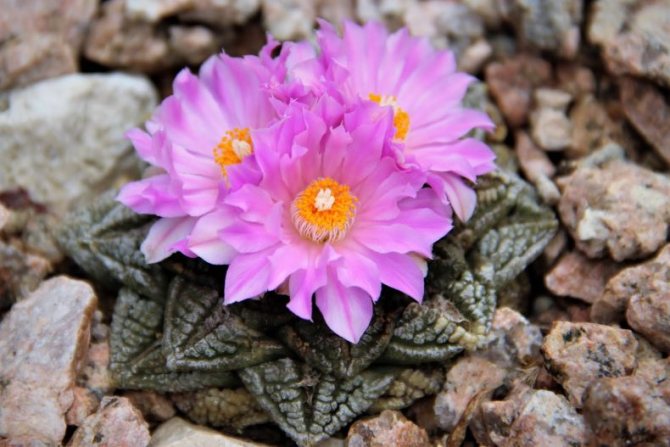
Unique features
Ariocarpus fissuratus is highly prized for its distinctive appearance and extremely slow growth. Its unique characteristics include:
- Resemblance to Rocks: This cactus has an appearance that makes it look like a rock or stone, helping it to camouflage itself in its natural environment. Its thick, fleshy leaves resemble small stones, giving it the common name of “Living Rock”.
- Slow growing: Ariocarpus fissuratus grows very slowly, taking several years to reach considerable size. This characteristic makes the plant even more precious among collectors and rare cactus enthusiasts.
Growing recommendations
To ensure that Ariocarpus fissuratus thrives, it is essential to follow some specific cultivation guidelines:
- Water requirements: This cactus requires little water, reflecting its arid natural habitat. Water sparingly, allowing the soil to dry out completely between waterings. During the winter months, reduce watering even more, as the plant goes into a state of dormancy. Excessive watering can lead to root rot.
- Soil type: Use a well-drained substrate, ideally a mixture of sandy soil or perlite. A specific substrate for cacti is recommended to ensure proper drainage and prevent moisture buildup, which can be harmful to the plant.
- Sun exposure: Ariocarpus fissuratus prefers locations with plenty of indirect sunlight or filtered light. Although it tolerates direct light, it is important to avoid prolonged exposure to intense sunlight, especially during the hottest hours of the day, to prevent burns. A place with partial shade in the afternoon is ideal.
- Temperature: This plant is adapted to hot temperatures and can tolerate extreme heat. However, it must be protected from very low temperatures and frost. Ideally, keep the plant at temperatures between 20°C and 30°C (68°F and 86°F).
- Pot: Choose pots with good drainage systems. Clay or ceramic pots are preferred, as they allow better evaporation of moisture, reducing the risk of root rot.
With this specific care, Ariocarpus fissuratus can become a fascinating and long-lasting addition to your succulent collection. Its rocky appearance and slow growth not only add an element of mystery and beauty, but also make this plant a real treasure for any lover of rare cacti.
5. Avonia papyracea (Paper Avonia)
Brief Description and Geographical Distribution
Avonia papyracea, known as “Paper Avonia”, is a succulent belonging to the Portulacaceae family. This plant is native to the arid regions of Namibia and South Africa. It grows in desert and semi-desert environments, where conditions are harsh and water is scarce. Its ability to thrive in such harsh conditions makes it a fascinating plant that is highly adapted to its natural habitat.

Distinctive features
Avonia papyracea is recognized for its unique features and delicate appearance:
- Stems Covered in White Bracts: The stems of Avonia papyracea are thin and delicate, covered in papyraceous (paper-like) white bracts, which help to reflect intense sunlight and reduce water loss. These bracts give the plant an elegant and ethereal appearance, making it quite distinctive among succulents.
- Delicate appearance: Despite its fragile appearance, Avonia papyracea is a hardy plant, adapted to surviving in extreme environmental conditions. Its delicate beauty and unique structure make it a charming addition to any succulent plant collection.
Maintenance Tips
To grow Avonia papyracea successfully, it’s important to follow a few specific guidelines:
- Light requirements: Avonia papyracea needs plenty of indirect sunlight to thrive. Place it in a spot where it receives bright but filtered light. Avoid direct exposure to intense sunlight during the hottest hours of the day, as this can cause burns to the delicate bracts.
- Wateringfrequency: Watering Avonia papyracea requires care and moderation. During spring and summer, when the plant is actively growing, water lightly, allowing the soil to dry out completely between waterings. In the fall and winter, reduce the frequency of watering, as the plant goes into dormancy and needs less water. Avoid overwatering, as this can lead to rotting of the roots and stems.
- Suitable environment: This plant prefers warm, dry environments. Avonia papyracea is well adapted to high temperatures, but must be protected from frost and extremely low temperatures. Keep it in an ideal temperature range between 20°C and 30°C (68°F and 86°F).
- Soil type: Use a well-drained substrate specifically for cacti and succulents. A sandy or perlite mix is ideal to ensure good drainage and prevent moisture build-up.
- Pot: Choose pots with good drainage systems. Clay or ceramic pots are recommended as they allow moisture to evaporate better, helping to keep the roots dry and healthy.
With this care, Avonia papyracea can flourish and maintain its delicate and distinctive appearance. Its ethereal beauty and unique structure are a delight for the eyes and an excellent addition for any lover of rare succulents.
How to Care for Rare Succulents
The Importance of Knowing the Specific Needs of Each Species
Caring for rare succulents can be a rewarding experience, but it requires careful attention to the specific needs of each species. Rare suc culents often have particular requirements in terms of light, water, soil and temperature, different from more common succulents. Understanding these needs is crucial to ensuring that your plants thrive and maintain their unique appearance. Before adding a rare succulent to your collection, research its native growing conditions and adapt your growing environment to mimic these conditions as best you can.
General Growing Recommendations
Although each species has its own particularities, some general growing practices can help keep rare succulents healthy:
- Watering: Most succulents prefer a watering regime that allows the soil to dry out completely between waterings. Overwatering is one of the most common causes of problems with succulents, leading to root rot. During the period of active growth (usually spring and summer), water moderately. In the dormant period (fall and winter), reduce the frequency of watering.
- Choice of pot: Use pots with good drainage systems. Clay or ceramic pots are recommended because they allow moisture to evaporate better. Avoid pots without drainage holes, as the accumulation of water can be fatal for succulents.
- Ideal substrate: Use a well-drained substrate specifically for cacti and succulents. Mixtures that include coarse sand, perlite or pumice will help improve drainage and prevent moisture build-up. An unsuitable substrate can retain too much water, damaging the roots.
How to identify and treat common problems
Even with the best care, rare succulents can face problems. Identifying and treating these problems quickly is essential to keeping your plants healthy.
- Overwatering: Signs of overwatering include soft, translucent and falling leaves. To treat, remove the plant from the soil, let the roots dry out completely and replant in a dry, well-drained substrate. Adjust your watering regime to avoid future problems.
- Pests: Common in succulents, pests such as mealybugs and spider mites can be identified by white spots, fine webs or damaged leaves. Treat pests by cleaning the plant with a mild soap and water solution or by using a suitable insecticide. For prevention, inspect your plants regularly and maintain good air circulation.
- Diseases: Fungi and root rot are common problems caused by excess humidity. Dark spots and soft areas on the stem or leaves can indicate a fungal infection. Treat by removing the affected parts and applying a fungicide. Make sure to adjust watering and improve drainage to prevent recurrences.
Keeping rare succulents healthy requires a balance between providing the necessary care and avoiding excess. By following these general recommendations and paying attention to the specific needs of each species, you can ensure that your rare succulents thrive and remain a vibrant and unique part of your collection.
Conclusion
Recap of the main points
Caring for rare succulents can be an incredibly rewarding journey. Throughout this guide, we’ve discussed the importance of understanding the specific needs of each species of rare succulent to ensure their healthy growth. We cover general cultivation recommendations, such as the importance of a proper watering regime, choosing a pot with good drainage and using a well-drained substrate. We also explore how to identify and treat common problems, such as overwatering, pests and diseases, to keep your plants vibrant and healthy.
Encouraging Readers to Explore the World of Rare Succulents
The world of rare succulents is vast and fascinating, full of unique and intriguing plants. Each species offers an opportunity to learn more about plants’ incredible adaptations to nature’s harshest conditions. Exploring and growing rare succulents can not only enrich your collection, but also provide a deep sense of fulfillment and connection with nature. Whether you are a beginner or an experienced collector, there is always something new and exciting to discover in this botanical universe.
Invitation to Share Experiences and Photos in the Comments
We invite you to share your experiences with rare succulents in the comments below. Which species do you grow? What challenges have you faced and overcome? We’d love to see photos of your rare succulents and hear your stories. Your participation not only enriches our community, but also helps other enthusiasts to learn and be inspired. Let’s cultivate this love of rare succulents together, exchanging tips, experiences and, above all, our passion for these incredible plants.
Frequently Asked Questions
What is the most expensive succulent in the world?
The most expensive succulent in the world is the Hoya carnosa ‘Compacta’ known as variegata or “Hindu Rope”. This plant can be extremely expensive due to its rarity, slow growth and the difficulty of propagation. Its curled, waxy leaves with variations in color make it a coveted piece for collectors, increasing its value on the market.
What is the most popular succulent?
The most sought-after succulent today is the Monstera deliciosa ‘Albo Variegata’. Although not technically a succulent, this plant is highly desired for its unique foliage with variations in white color. The high demand is due to its exotic appearance, propagation difficulties and the fact that it is a very popular indoor plant in decoration trends.
What is the rarest succulent in existence?
The rarest succulent in existence is the Adromischus marianae ‘Herrei’, an extremely difficult plant to find both in the wild and in cultivation. Originally from South Africa, it is prized for its tubular leaves with a rough texture and vibrant colors. Its rarity is attributed to its limited distribution and very slow growth, making it a rare gem for succulent collectors.
